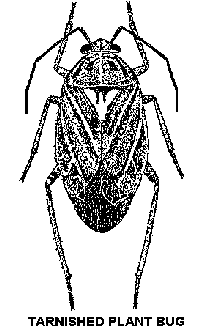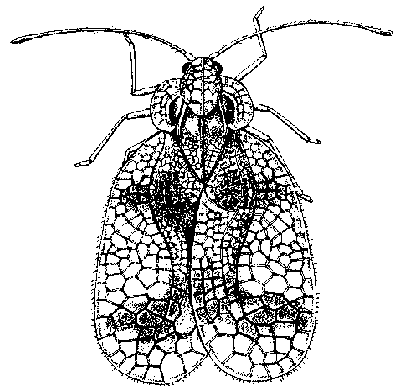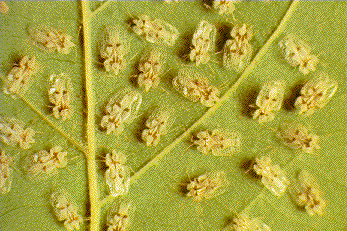Plant Bugs and Lacebugs
ENTFACT-419: Plant Bugs and Lacebugs | Download PDF
by Brian Skinnell and Lee Townsend, University of Kentucky Entomology
University of Kentucky College of Agriculture
Plant bugs and lacebugs use their sucking mouthparts to feed on plant sap. Damage ranges from many small white spots on the leaves to distortion or destruction of plant tissue, depending on the pest and host plant. Some feed on many different types of plants while others feed only on a narrow range or single species.
Adults fly readily and are often gone before symptoms appear. Their injury is often light to moderate and widely distributed. In contrast, the immature or nymphal stages are wingless and can move only by walking. Injury builds slowly but can become very intense as the insects near maturity. In addition to the feeding damage, white cast skins and tarry waste specks may be seen when nymphs have been present for a long time. The adult and nymphal stages of the same species can look very different, which can confuse identification.
COMMON SPECIES
Plant Bugs

Tarnished Plant Bug
Fourlined plant bugs feed on many herbaceous and woody ornamentals including currant, rose, forsythia, sumac, and viburnum. The nymphs are bright red or yellow, adults is yellow to yellowgreen. Both stages have four distinct black lines running the length of the body, hence their name.
This plant bug can be very destructive, especially to herbs and mint. It feeds first on the upper, tender foliage leaving distinct redbrown spots. These spots, the plant's reaction to enzymes injected into the leaf by the insect, can range from white to almost black depending on the host. Feeding by large numbers of plant bugs can produce large brown blotches and/or leaf distortion.
Females cut slits into the host plant and lay six to eight eggs inside. There is one generation a year. It occurs during a six-week period from late May through June.
Honeylocust plant bugs, are 3/16" long light green insects that cause honeylocust and black locust foliage to become discolored, stunted, or deformed. These insects do their damage early in the spring but the symptoms persist through the season. Severe infestation can even cause twig dieback. Adults occur from late May to early July. There is one generation occurs per year, eggs are laid in the woody tissue and overwinter there. On problem trees, watch carefully for signs of activity in the spring. Examine terminal foliage for presence of the insects. Treat when leaves first open with Insecticidal Soap, Malathion, Sevin, or Tempo.
The tarnished plant bug overwinters as an adult and becomes active when leaves first begin to form. This insect feeds on weeds, vegetables, fruit, flowers, shrubs, and trees. There are several generations each year. Adults, which have a distinct yellow "Y" on their backs, are good fliers and move about easily. Symptoms produced vary among the different hosts.
Lacebugs
Adult lacebugs are 1/8" to 3/16" long insects with clear, ornate, lacy wings. Nymphs are spiny and wingless. Feeding results in spotted leaves and dark, varnish-like excrement on the under sides. With broadleaved evergreens it is doubly important to prevent damage because the foliage will retain the ugly injury and be less functional for more than one year.

Lace Bug
Most lacebugs spend the winter as eggs that hatch in early spring. There may be several generations during a season. With multi-generation species, numbers early in the season are so small that feeding symptoms may not be noticed. Populations peak in late summer and results of their feeding can make plants unsightly.
Azalea lacebugs are about 1/8" long with light brown bodies. They prefer evergreen varieties but attack deciduous varieties and mountain laurel. Sap removal by adults and nymphs causes a spotting visible on the upper leaves. In heavy infestations, leaves may be white an drop prematurely. Spots of their tarry excrement build up on the under sides of the leaves.
The lacy wings of the adults have dark brown to black markings, nymphs are black and spiny. Populations are greatest in mid- to late summer as the second generation bugs appear.

Sycamore Lace Bug
Sycamore lacebugs have the same general life cycle as the azalea lacebug. In addition to symptoms on the foliage, the insects may fall from the trees onto people below. Attempts by lacebugs to probe can result in a "bite" sensation which can be very annoying, especially when lacebug are at their peak. Some people may have a slight reaction to the bite but the insects are not a health threat.
CONTROL
Repeated treatments may be needed to control these pests effectively. Insecticides such as Insecticidal Soap, Summer Horticultural Oils, Malathion, Orthene, Sevin may be used depending on the species or cultivar. Always read product labels carefully before purchase. Look for information on phytotoxicity that can occur on sensitive plants or under some environmental conditions.
Check for infestations so that a treatment can be applied before the plants are disfigured by the pest. Thorough treatment of the undersides of the leaves is needed for best results.
Revised: 7/19
CAUTION! Pesticide recommendations in this publication are registered for use in Kentucky, USA ONLY! The use of some products may not be legal in your state or country. Please check with your local county agent or regulatory official before using any pesticide mentioned in this publication.
Of course, ALWAYS READ AND FOLLOW LABEL DIRECTIONS FOR SAFE USE OF ANY PESTICIDE!
Images: University of Kentucky Entomology.
